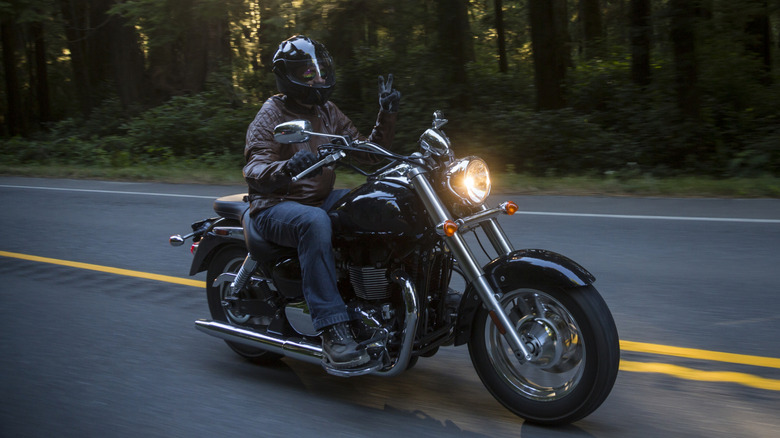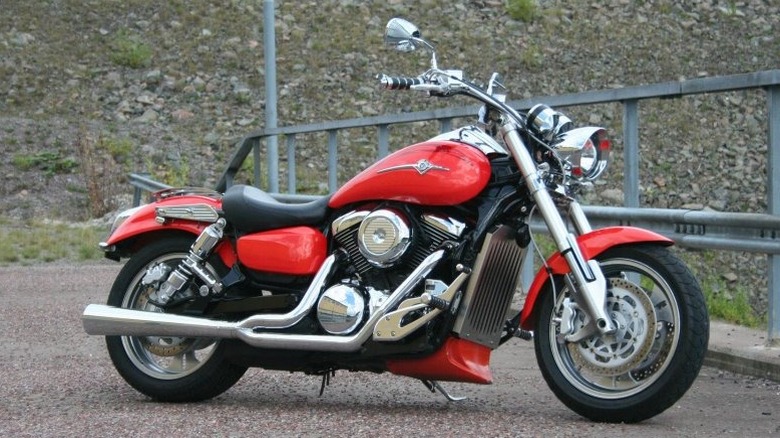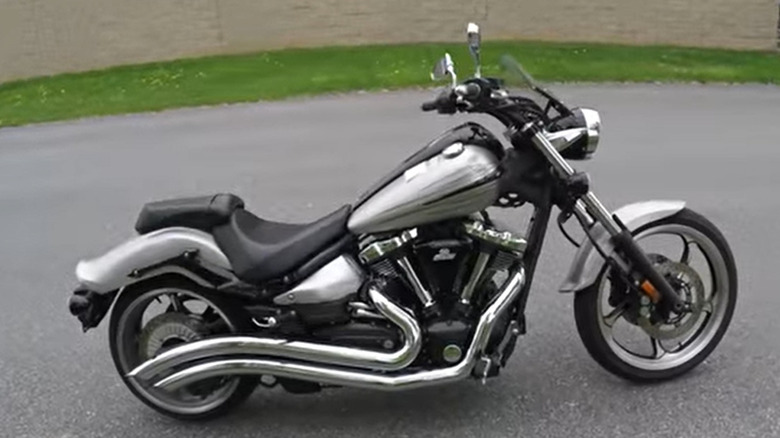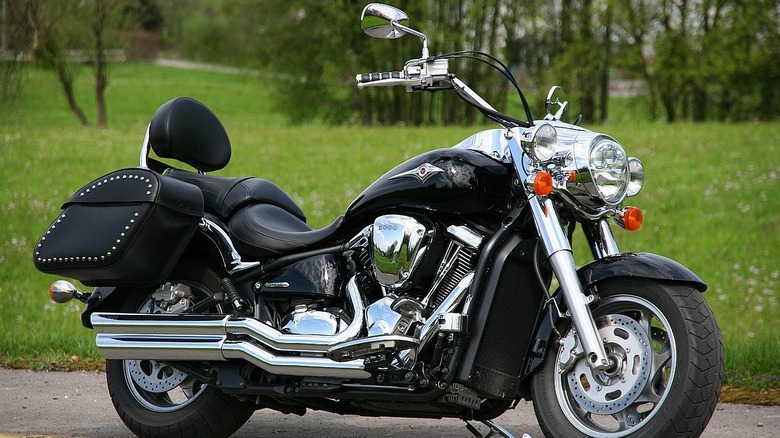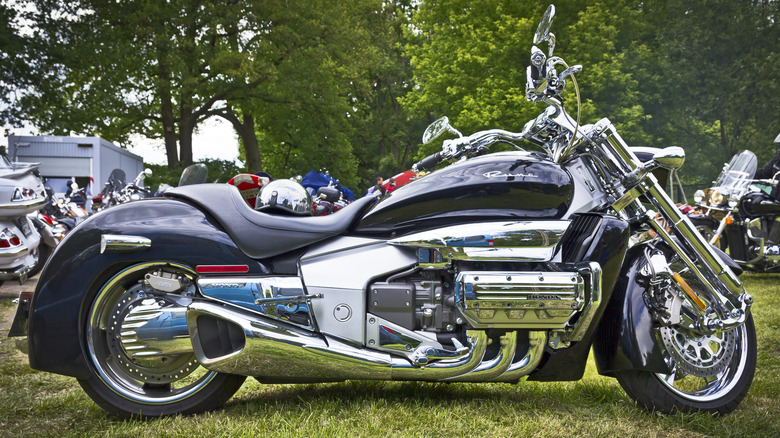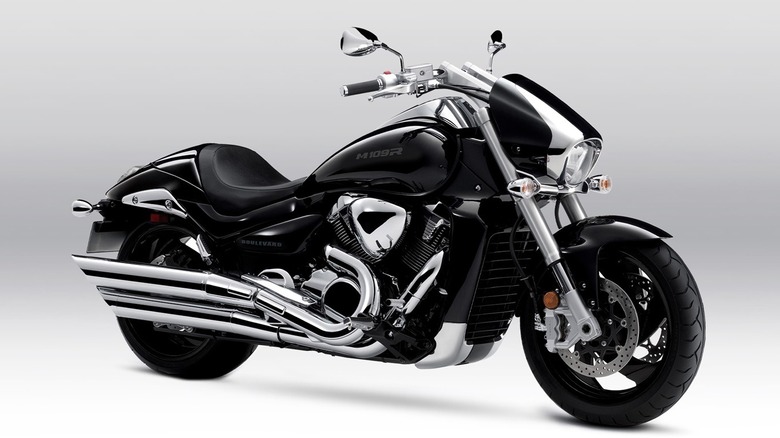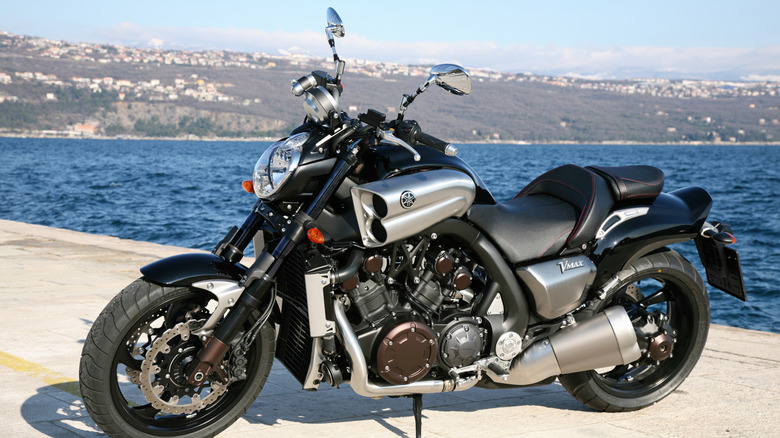9 Of The Most Powerful Japanese Cruiser Motorcycles, Ranked By Horsepower
Cruiser motorcycles come in different shapes and sizes, although the definition may vary a bit depending on who you ask. Some purists might argue that Harley-Davidson is the only purveyor of the true cruising ethos. Others prefer the pitter-patter of BMW's flat-twin engines winding through the Bavarian countryside. Still more would step outside brand loyalty entirely and define a cruiser based on engine type or riding position.
The major Japanese manufacturers — Honda, Yamaha, Kawasaki, and Suzuki — have been putting forth quality motorcycles of every stripe for decades. Whatever Europe and the United States have in the motorcycle market, Japan has an answer. The companies are especially known for supersport bikes, which are essentially race bikes for the street. As they're sometimes known, the Big Four build everything from 50 cubic centimeter (cc) commuter scooters to the biggest and baddest highway hogs on the planet. Whatever type of riding you prefer, Japan has something for you — and this includes cruisers.
Personal opinions of what makes a cruiser notwithstanding, we cast a wide net for the most powerful Japanese versions. The general rule for this article was that the bike had to have a generally laid-back riding position and should primarily be designed for moderate to long-distance road cruising. Engines include everything from V-twins to flat-sixes, inline fours, and anything in between. To measure power, we used good old fashioned horsepower. Torque plays an enormous role in an enjoyable cruise, but rest assured that with horsepower numbers, torque isn't far behind.
In honor of the Big Four, we present nine of the most powerful Japanese cruisers, ranked by horsepower.
Kawasaki Mean Streak -- 74 horsepower
Kawasaki embarked on a bold venture into big-displacement cruisers around the mid-2000s, creating along the way some of the most powerful machines in its history. While some companies squeeze every bit of power they can out of mid- or low- displacement bikes, Kawasaki was an adherent to the bigger is better ethos. Out of that philosophy was born the Mean Streak.
Japan clearly understood Harley-Davidson's appeal. While the American company has had its ups and downs, there is something people love about its V-twin-powered cruising style. In an attempt to break into that segment of the market, Kawasaki introduced its Vulcan line in the mid-1980s. Initially a mid-sized cruiser, over the years Kawasaki kept building on the line with added displacement, generating some very competent cruisers in the meantime.
The Mean Streak 1500 cc edition appeared in 2002. Its 1,552 cc V-twin four-stroke engine made 73 horsepower at 5,500 rpm and 93 lb-ft of torque at 2,500 rpm. It might not dazzle in terms of horsepower compared to super sport bikes, but it was low, lean, and as mean as advertised. Besides that, the joy of a twin is in the torque.
Kawasaki kept the Mean Streak going until 2009 when it dropped it from its lineup. If a big, mean V-twin with a low rumble, plenty of pull, and an MSRP well below its Harley competition is in your future, the used market has plenty to choose from.
Honda Rebel 1100 – 87 horsepower
Honda has a history as a byword for reliability and performance in a wide range of engine-powered vehicles. In addition to its vaunted Gold Wing touring bike — more on that later — Honda's versatile Rebel line is also in the market. The versatile nameplate has served a number of purposes, but all have revolved around a laid-back and forgiving riding experience that covers everyone from the novice learner to the experienced highway hellion. Though many will recognize the Rebel as a stellar 250 cc beginner bike used by many motorcycle licensing schools, the Rebel grows all the way up to 1,100 cc — with power to match.
The 2025 Rebel 1100 is the latest (and largest) Rebel to hit the streets. Powering the big-boy version of the bike is a parallel-twin 1,084 cc derived from Honda's Africa Twin off-road bike. It might not be what you're looking for if you yearn for the idiosyncrasies of a V-twin, but the four-stroke still brings 87 horsepower to the party. That might not sound like a ton if you're used to reading articles about the latest hypercar, but our Honda Rebel 1100 review said it's plenty.
The Rebel adopts a low-saddled stance that serves its 59.8-inch wheelbase and raked fork well, resulting in a classic around-town cruiser look. It has shied away from its initial chromed look in favor of a smoked tubular frame that recalls the Harley-Davidson V-Rod and presents an overall modernized and unique vibe not found on many other contemporary cruisers. It might not hit the power numbers of the big Harleys, but it'll also cost a lot less brand-new, and it comes with Honda's quality and reliability.
Yamaha Raider 1900 – 100 horsepower
In recent years, Yamaha has largely bowed out of the cruiser-style bike in favor of half-naked streetfighters and a shifting sportbike strategy. While the 942 cc Bolt R-Spec presents some respectable performance statistics, we reach back a few years to its Star line to find enough power to make this list.
The Raider undoubtedly pulls inspiration from the heyday of the American chopper motorcycle. In the words of the author's father, it's a "wannabe" –- as in it aspires to be a Harley-Davidson. Despite that, there's plenty to appreciate the attitude of the Raider — even for dedicated Harley enthusiasts. If wanting to be a Harley-Davidson truly was behind the design ethos of the Raider, it does an admirable job. A six-degree raked front end, chrome everywhere, a devilishly curved exhaust, and a big, loud V-twin engine check most of the Harley boxes.
The Raider was no slouch in the power department either. The 1,854 cc pushrod V-twin is something any Harley fan would enjoy as long as it had the right brand name emblazoned on the side. A five-speed transmission, wet clutch, and 46 mm front forks with over 5 inches of travel give it all the ingredients for a smooth, powerful cruising experience. The 2015 Yamaha XV 1900 Raider SE put out 100 fuel-injected horsepower at 4,250 rpm and 124 lb-ft of torque at 2,500 rpm.
Kawasaki ZL900 Eliminator – 103 horsepower
Supersport bikes were on the rise but had yet to attain the candy-coated cladding of full fairings when the Kawasaki ZL900 Eliminator hit the scene in 1985. The ZL900 definitely took notes from American cruisers with its drag-style handlebars, raked front fork, and teardrop tank. At a glance, it would fit well into the twin cruisers dotting the highways, but beneath the aesthetics lurked a special engine that would make a Sportster rider envious. A 105-horsepower 908 cc inline-four cylinder drew inspiration from the legendary proto-Ninja GPZ900R. Still, it had an upright seating position and a cruiser's chrome and paint design aesthetic.
The ZL900 dropped the same model year as the Yamaha V-Max, helping to kickstart a category that would later be described as muscle bikes. However you define it, the Eliminator had enough horsepower to make it among the most powerful Japanese cruiser-style bikes, even compared to those like the Yamaha Raider, which had oodles more displacement. Unfortunately, Kawasaki's bid to be at the top of the genre fell a little flatter than it envisioned. The ZL900 Eliminator only lasted a year before evolving into the ZL1000, which sold until 1990. The Eliminator nameplate still lives on in various forms, but mostly as smaller commuters.
Kawasaki Vulcan 2000 – 114 horsepower
The Mean Streak wasn't the only big cruiser bike Kawasaki put forth. For straight-up displacement, it's tough to top the Vulcan 2000. Kawasaki spent three and a half years designing and building what would become the largest displacement motorcycle in the cruising category. At 2,053 cc, each of the Vulcan 2000's twin cylinders has more boom room than an entire literbike.
The Vulcan line, a significant part of Kawasaki's history, traces back to the 1980s, the golden era of the Universal Japanese Motorcycle. The introduction of V-twin-powered cruisers alongside the inline four UJMs was a strategic move to compete with Harley-Davidson's dominance. The first Vulcan, a 750 cc V-twin, was launched in 1984, marking the beginning of a legacy that continues today. The Vulcan 2000, with its exceptional power, was a significant milestone in this journey.
Debuting in 2004, the last Vulcan rolled off the line in 2010. At its height, the Vulcan 2000 Classic LT claimed a respectable 114 horsepower, but its torque measurement had the rare distinction of being more than its horsepower number at 141 ft-lbs. You'd need all that pull, too, because this gargantuan bike had a wet weight of 884 pounds.
Honda Valkyrie Rune – 118 horsepower
Many cruiser-style motorcycles borrow design elements from vintage bikes. The category is inherently anachronistic, and some of the most popular cruisers today look like they might have rolled out of the factory in the 1950s. Honda's Valkyrie Rune is a definite departure from this design ethos. The bike looks like it could belong in a museum exhibit for concept vehicles that were never built. That is, in fact, half the story. The Rune traces its lineage to the 1995 Honda Zodia concept, which straight up looked like Cloud Strife's bike from the PlayStation classic "Final Fantasy VII."
Back in this iteration of the multiverse, Honda brought the Rune to market in 2003 with a $27,000 MSRP. Polarizing, to say the least, but those who loved the fantasy bike snapped it up. After all, fantasy must have been in the minds of Honda's engineers — the motorcycle reportedly cost over $100,000 to produce. Clearly, Honda was trying to make a statement rather than turn a profit. One would be forgiven for thinking it came from a Moto Guzzi or BMW plant. Whatever the inspiration and motivation behind it, the Rune was unmistakably, undeniably a cruiser. At 8 feet long and weighing nearly 900 pounds, it had to be.
With stats like that, the Rune had to have a powerful engine. Honda had been putting flat engines in its bikes since at least 1975. Maybe the temptation to incorporate it outside the Gold Wing was just too much for the engineers to resist. The result was a polarizing, silky smooth, 1,832 cc cruiser that boasted 118 horsepower and an eyebrow-raising 121 lb-ft of torque.
Honda Gold Wing -- 120 horsepower
Speaking of Honda's flat-six engines, the year 2025 marks the 50th anniversary of Honda's venerable Gold Wing. More than just a cruiser, the Gold Wing has been the gold standard of long-distance touring for decades. But you sure can cruise on it, too. Just set the cruise control, settle back on the plush leather seating, and enjoy the ride blasting your favorite tunes. It is the old Cadillac of the motorcycle world, big, luxurious, and the gold standard for touring.
Unlike many of the cruisers on this list, the Gold Wing eschews the V-engine configuration in favor of the low center of gravity and balanced power delivery of a flat-six. The 1,833 cc horizontally-opposed six-cylinder makes 120 horsepower at 5,500 rpm and 126 lb-ft of torque at 4,500 rpm. That's plenty of power, even for a bike that weighs 856 pounds in the top-tier Tour Airbag DCT trim.
The Gold Wing is all about being manageable and comfortable to ride, which sets it apart from some of the more visceral motorcycles dotting this list. It incorporates a slew of life- and ride-enhancing widgets, including a reverse gear, Apple CarPlay and Android Auto wireless integration, a full fairing, and (shudder) an available automatic transmission. Wherever you land on the cruising spectrum, the Gold Wing offers the top cruising experience for those who want to rack up the miles on multi-day road trips.
Suzuki Boulevard M109R – 128 horsepower
If the thump of a big V-twin engine gets your heart palpitating, the Suzuki Boulevard M109R can get you to the cardiologist lickety-split. With an engine housing two of the largest pistons on the market, Suzuki's king cruiser makes serious horsepower.
One look at the Boulevard tells you half of what you need to know. Its sweeping lines and chrome design make it look like it's thundering down the highway, even when sitting on its kickstand. Drag bars, a solo-seat cowl, and a unique headlight case don't make it look mean, per se — but they don't look overly kind, either. The Boulevard is the modern answer to Kawasaki's Mean Streak, but Suzuki's engineering department went overboard, cramming as much power into the M109R as possible.
The other half of the equation is nestled at the core of the chassis in the form of a fuel-injected, eight-valve 54° V-twin engine displacing 1,783 cc. The fact that it has 128 horsepower is impressive, but what really sets the Boulevard apart is its 118 lb-ft of torque, which means riders can find power in any gear. Its one of the most powerful in-production cruisers available today, and that includes cruisers developed and built outside of Japan.
The 2025 Boulevard might be the latest, but if top-of-the-line is a necessity, check out the Blacked Out Suzuki Special (B.O.S.S.) edition. This special edition features racing internals, including forged aluminum pistons and a cast aluminum swingarm, which enhance its performance and give it a distinct look. It's not just a powerful cruiser, it is one of the most powerful motorcycles Suzuki ever made.
Yamaha V-Max – 143 to 197 horsepower
If you're a sportbike fanatic at heart but need to make the switch to something a little more comfortable, look no further than the Yamaha V-Max — just make sure it's not your first motorcycle. Yamaha pulled out all the stops, melding the power and performance of super sports with the look and ethos of a cruiser. The resulting muscle bike terrorized drag strips (and the author's neighborhood, since the cool guy up the street used to rip past on his V-Max regularly) for years.
Though discontinued in 2020, Yamaha built the V-Max through three generations beginning in 1985. The first iteration was a mad muscle-bike mashup making 143 horsepower via a 1,198cc V4 engine. The Max must stand for an extra two cylinders because this bad boy brought the high-revving balance of four cylinders together with the grip-loosening pull of a torque V-twin. To be honest, it makes the craziest kind of sense.
Yamaha didn't let off the gas, either. Each new V-Max was more powerful than the previous one, culminating in the final 2020 edition. By then, displacement had leaped to 1,679 cc, making nearly 200 horsepower, putting it in the same conversation as Yamaha's legendary YZF-R1 race bike.
Performance specs aside, the V-Max could be described as a muscle bike, but it definitely takes cues from the cruising culture. Whether blacked out or chromed to the gills, the V-Max's upright seating position, exposed engine, and drag strip presence make it a great cruiser — if you can handle it.
